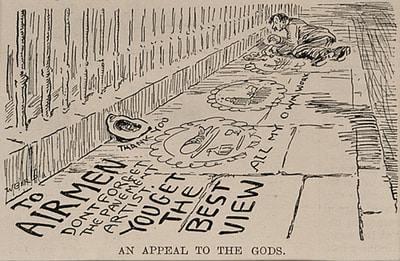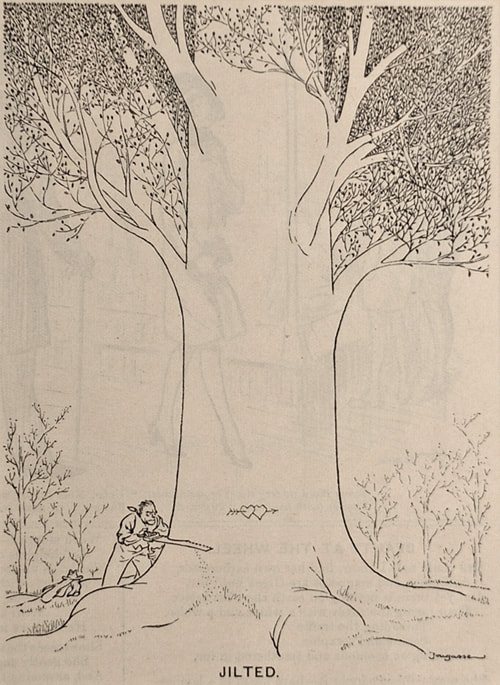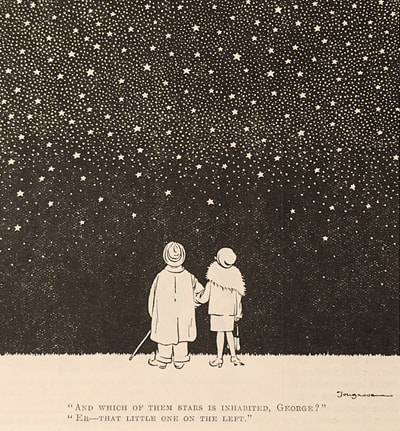|
During the First World War, Kenneth Bird was hospitalised following an injury to his spine sustained at Gallipoli in 1915. Prior to the war, Bird had been an instructor with the Artists’ Rifles and had worked at the Rosyth naval base. ‘Horribly wounded… [he] realised he would have to find something to do which would not overtax him physically.’ (Anderson, p.156). Having earlier attended evening classes in art at Regent Street Polytechnic, that ‘something’ was cartoons and illustrations which Bird submitted to numerous publications. His first cartoon for Punch, below, was published in 1916. When War’s Brutalising Influence was published there was another artist submitting to Punch who signed his work ‘W. Bird’. For this reason, Kenneth Bird adopted the name ‘Fougasse’, a small improvised land mine of the type he would have encountered during the war, for his cartoons, illustrations and designs. The other cartoonist wasn’t actually a Bird at all. ‘W. Bird’ was Jack Butler Yeats, author, Olympic medallist and Ireland’s most influential artist of the twentieth century. As can be seen in the images above, Yeats’ submissions to Punch are characterised by a free-flowing, loosely handled style. This approach, so expressively forceful, vibrant and modern when employed by Yeats in colour on canvas, looked, to a contemporary audience, hasty, sketchy and somewhat amateurish in black and white. As Price (p.209) related, ‘Townsend and Seaman [Punch’s Art Editor and Editor at the time] continued to print… Bird, though many readers must have brought pressure on them, attacking Bird’s drawings as not representing reality.’ In fact, Bird’s drawings did represent reality – they just didn’t represent it in the manner to which Punch readers had become accustomed, as the two cartoons below (Yeats left; G D Armour, a contemporary Punch cartoonist, right) illustrate. Leaving aside the merits or demerits of the humour, Yeats’ cartoons are published sketches whereas Fougasse’s are coherent and fully formed designs. They possess an intrinsic strength of line coupled with the parsimony of a dedicated minimalist to show just enough to carry the joke or make the point. Whether it was two fellows negatively silhouetted against a hatched hedge or two others before an Underground station, Fougasse clearly understood that, when working in monochrome, sparseness can be strength. They were modern, too, and would have seemed so to contemporary eyes. There is a timeless element to Fougasse’s more successful cartoons. If you’d have found Jilted, above, funny in 1926 there is no reason not to find it funny today. It doesn’t require an understanding of time and place for the laugh; all the viewer needs is an emotional connection to the subject. Such a work is relevant today in part because it deals with a universally understood situation and also because of the strength of the cartoon’s design. This design ethic runs through Fougasse’s work – he instinctively knew where to place a line and, crucially, when to leave a line out. He also understood the impact bold contrast could produce. In 1937, Fougasse was made Art Editor of Punch and continued to publish his own drawings. Over time, his technique simplified further, becoming even more stripped back and to the point. His mature style was employed to great effect during the Second World War in the ‘Careless Talk Costs Lives’ propaganda posters he designed for the Ministry of Information. In 1949, Fougasse was made Punch Editor, the only cartoonist in the history of the magazine to hold the position.
Yeats, too, continued to submit ‘W. Bird’ cartoons to Punch until 1941. Away from his published drawings, his individual, expressionist paintings ‘helped articulate a modern Ireland of the twentieth century’ (Brennan, 2007). Additionally, he published novels, wrote plays and designed sets for the Abbey Theatre, Dublin. In 1924, following the establishment of the Irish Free State, Yeats won the country’s first medal at the modern Olympic Games. The discipline was Painting and Yeats was awarded the silver medal for a work titled The Liffey Swim. Painting was one of the Arts categories which featured at Olympic competitions from 1912 to 1948. Our full selection of Punch cartoons can be seen here. Our biographies of Bird, Yeats and other Punch cartoonists can be seen here. Sources and further reading Anderson A (1982), The Man Who Was H M Bateman, Webb and Bower Brennan S (2007), A speech delivered at the National Gallery of Ireland Bryant M and Heneage S (1994), Dictionary of British Cartoonists and Caricaturists 1730-1980, Scolar Press Price R G G ((1957), A History of Punch, Collins Comments are closed.
|











 RSS Feed
RSS Feed